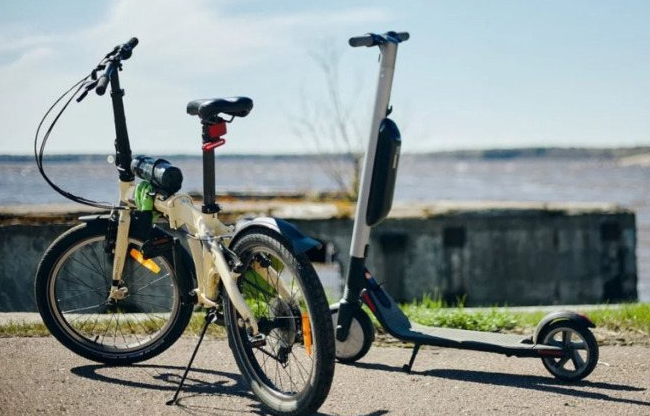In recent years, electric vehicles have become increasingly popular in urban environments. Among them, electric bicycles and electric scooters occupy a special place, offering convenient and environmentally friendly alternatives to car journeys. But how to choose between these two? Let’s take a closer look at their comparative characteristics.
Comfort and ease of use
- Electric bikes offer a high level of comfort with a seat and pedalling capability, allowing the rider to adjust the level of physical exertion. They are ideal for long journeys and can cope with a variety of road conditions, including climbs. Most models are equipped with shifters, making it easy to ride through difficult terrain.
- Electric scooters, on the other hand, win in terms of lightness and manoeuvrability. They are ideal for short journeys around the city. Standard models are equipped with a footrest and a handlebar, making them easy to use. However, they may be less comfortable for longer journeys due to the lack of a seat.
Performance and range
- Electric bikes combine power and efficiency, making them the perfect choice for those looking for range and speed:
Battery and motor: Thanks to extensive technological innovations, electric bikes are equipped with large and powerful batteries as well as high-performance motors. This gives them an impressive range of up to 80-100 kilometres or even more on a single charge, depending on usage conditions such as terrain type, rider weight and level of assistance.
Speed: With the ability to reach speeds of 25 to 45 km/h, electric bikes offer excellent performance, making them a great choice not only for long rides in the countryside, but also for travelling quickly and efficiently on city streets.
- Electric scooters, on the other hand, are a lighter and more compact option optimised for short urban trips:
Battery and motor: Despite the more modest battery and motor size compared to electric bikes, electric scooters offer a decent range of between 20-40 kilometres on a single charge. This is ideal for everyday city rides, meeting friends or short business visits.
Speed: Although the maximum speed of electric scooters does not usually exceed 25 km/h, this is sufficient for comfortable urban mobility. A slower speed also contributes to increased safety when riding in dense urban traffic.
Manoeuvrability comparison
- Although electric bikes are not as light and compact as electric scooters, they still offer good manoeuvrability, especially in models with narrow wheels and optimised frame geometry. They are able to move confidently in city traffic, overtaking traffic jams and avoiding obstacles on the road. They also have the advantage that they can be used on cycle paths where there are fewer obstacles compared to pavements or motorways. Electric bikes are equipped with larger handlebars, which gives better steering control, especially when cornering and manoeuvring in tight spaces.
- Electric scooters stand out for their outstanding manoeuvrability in urban environments. Their light weight and compact dimensions make them ideal for manoeuvring through crowds of pedestrians, narrow alleys and dense city traffic. In addition, electric scooters are often equipped with swivel mechanisms that allow for very precise directional control, making them particularly handy for short manoeuvres. With the ability to stop and start quickly, they also offer improved adaptability to changing traffic conditions. This makes electric scooters a particularly attractive choice for those looking for the most flexible and manoeuvrable means of getting around town.
Versatility and adaptability
- Electric bikes are highly versatile: they can be used for both urban and cross-country cycling. Many models are equipped with shock absorbers and special tyres for off-road use, extending their functionality.
- Electric scooters are more limited in this regard because of their design. They are best suited for smooth asphalt roads and pavements, while their use on uneven surfaces can be uncomfortable or even dangerous.
Travelling on various surfaces and ascents
- Electric bikes are equipped to handle a wide range of road conditions due to their unique features:
Different surfaces: The electric bikes’ large wheels and often integrated suspension allow them to easily adapt to a variety of surfaces, from smooth city roads to rough terrain. Tyres designed for everything from light off-road to tarmac provide good grip and handling on any surface.
Climbing: The powerful motors on most electric bikes provide excellent support on climbs, even steep ones. This makes electric bikes the ideal choice for hilly areas or if you need to tackle frequent climbs on your route.
- Electric scooters, on the other hand, have their own limitations and advantages when used in different environments:
Different surfaces: Because of their smaller wheels and lack of suspension, electric scooters do best on flat, paved surfaces. Irregularities such as potholes, cracks in the road or paving stones can make it difficult to steer and ride comfortably. They are therefore not the optimal choice for travelling over rough terrain or uneven roads.
Climbing: Although today’s electric scooters are equipped with motors powerful enough to tackle small to medium gradients, they may lack power on steep gradients and the rider may need to exert extra effort to climb. This is especially true for models with lower motor power or when riding in difficult conditions.
Transport and storage
- One of the main advantages of electric scooters is their compactness. Most models are foldable, making them easy to store and transport on public transport. This makes them an ideal choice for people looking for a convenient way to travel short distances.
- Electric bikes, while they can be more bulky, also often offer options for easy storage and transport, such as folding frames. However, due to their larger size and weight, they can be less convenient in this respect compared to electric scooters.
Comparison of price and availability
- Price: Electric bikes tend to be more expensive than electric scooters because of their power, complexity and versatility. However, the price of electric scooters can also vary depending on their features.
- Availability: Both types of transport are widely available both in shops and online. However, in urban settings, electric scooters are often available through rental systems, making them even more convenient for short-term use.
The choice between an electric bicycle and an electric scooter depends on your individual needs, lifestyle and riding preferences. Electric bikes offer greater range, comfort and versatility for long journeys and varied routes. Electric scooters, on the other hand, win on lightness, manoeuvrability and ease of storage, being the ideal choice for short urban journeys. Whichever option you choose, remember that using electric transport not only saves you time and money, but also helps to reduce pollution.
Discover the convenience and benefits of electric transport with reBITme and make your choice in favour of a sustainable future without forgetting the savings!





